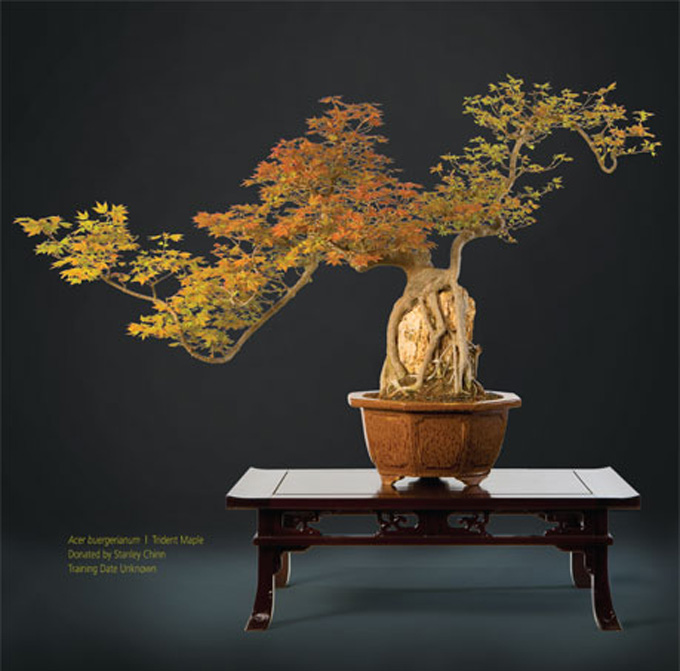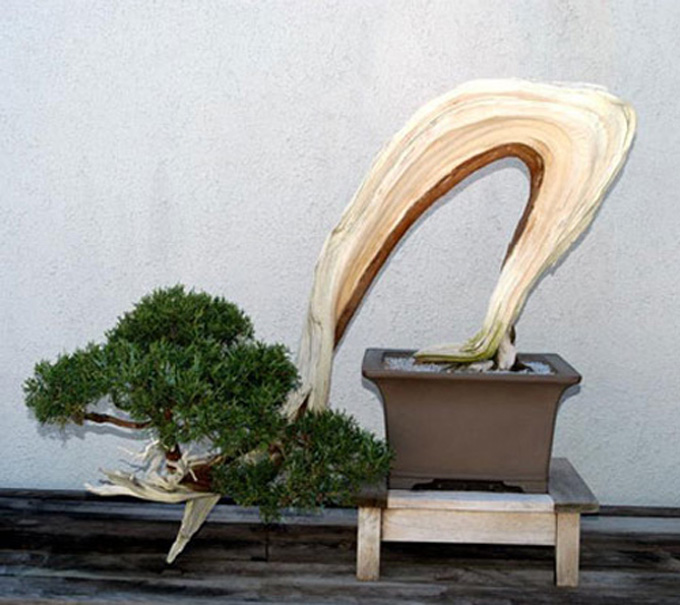 Sometimes it’s helpful to break a bonsai down into its constituent parts. What you might see in this case, is a somewhat classical root-over-rock Trident maple bonsai accentuated by two rather long, undulating branches on either side. For some of us, there might be a temptation to cut them off; to revert to something safer and more recognizable as bonsai. Don’t do it! The photo is from the National Bonsai Foundation’s 2013 calendar.
Sometimes it’s helpful to break a bonsai down into its constituent parts. What you might see in this case, is a somewhat classical root-over-rock Trident maple bonsai accentuated by two rather long, undulating branches on either side. For some of us, there might be a temptation to cut them off; to revert to something safer and more recognizable as bonsai. Don’t do it! The photo is from the National Bonsai Foundation’s 2013 calendar.
Mr. California Juniper at the National Bonsai and Penjing Museum. The event is the annual Potomac Bonsai Festival which happens to be coming up this weekend (May 3-5, my apologies for the late notice). It features Harry Hirao (aka Mr. California juniper) and is something not to be missed. Even if you have to change your plans and book a last minute flight (I’m only half-joking, you may never have another opportunity to see Harry in action).
The Potomac Bonsai Festival is co-sponsored by the National Arboretum, the National Bonsai Foundation, and the Potomac Bonsai Association and held at the National Bonsai and Penjing Museum. For more on this event and other events at Museum, check out he National Bonsai Foundation’s 2013 calendar.
BTW: I wonder if the two long branches on the tree above were originally left on as sacrifice branches (branches that are left on a tree to speed growth and thickening – often to develop taper – and that are later removed) and then at some point the artist (Stanley Chinn) realized how much they enhance the tree, so he decided to leave them on. Or…?
 This famous Harry Hirao California juniper resides at the National Bonsai and Penjing Museum.
This famous Harry Hirao California juniper resides at the National Bonsai and Penjing Museum.
Looking at the trident I think of a distant ridge with trees on the skyline. The branches form the line of the ridge with the trees above it. The rock and “trunk” in this case are the stand for an unconventional landscape or forest planting. Almost a raft without roots.
This looks to me how a tree would look hanging on for dear life, by clinging to a rock on a cliff or river embankment.
Very interesting observation re’ Stanley Chinn’s trident possibly revealing its design from unsacrificed branches. His styling of artistic plants has often been distinct… like the ink traces of some calligraphers. Capturing the personality of a unique designer’s work, many images of Stanley’s trees have been posted on “Flickr” at http://www.flickr.com/groups/1822696@N23/.
Seeing Harry at this weekend’s _Potomac Bonsai Festival_ is sure to be memorable! Thanks for sharing… :-)
Chinn’s tree is called dragon. Head on right tail on left. Chinese used to shape trees for the signs of the zodiac.